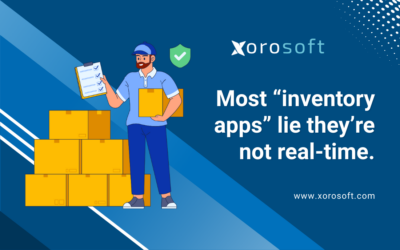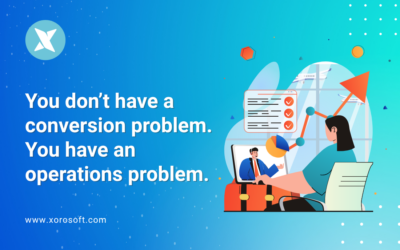
The Real Source of Operational Stress
Workflow automation software is becoming essential for ecommerce brands, especially because most operational stress comes from broken workflows rather than growth itself. Although many founders believe the pressure is caused by higher order volume or channel expansion, the real issue usually comes from scattered tools, manual processes, and disconnected systems. As a result, teams spend more time fixing problems than running the business. When workflows are automated and centralized, the entire operation feels lighter, faster, and more predictable.
Therefore, the path to calm operations rarely begins with working harder. It starts with removing the operational noise caused by systems that do not speak to each other. Once workflows run through a centralized, cloud-based system like Xorosoft ERP, the pace of the business becomes predictable again.
Why Workflow Automation Software Prevents Breakdowns in Ecommerce
As ecommerce companies scale, they often add tools to solve immediate problems. However, these individual tools create isolated data and disconnected processes. Because order data flows one way, inventory updates lag. In addition, warehouse teams follow inconsistent steps since their systems do not guide them. Accounting falls behind because financial and operational data never meet in one place. Consequently, leaders find themselves reacting instead of directing.
Although these problems feel different, they all share one root cause: a fragmented workflow. Modern workflow automation software removes this fragmentation. Because it connects every step—from order capture to accounting—the entire operation moves as one system rather than a cluster of tools.
How Xorosoft Uses Workflow Automation to Create Operational Calm
Most operators are not looking for more technology. Rather, they want fewer tools that do more work. This is where Xorosoft ERP stands out. The platform is cloud-native, fast to deploy, and built to replace spreadsheets, QuickBooks stacks, disconnected WMS tools, and shipping apps. Since it includes a built-in WMS, real-time inventory tracking, procurement automation, accounting, and reporting, it removes the need for bolt-on systems.
Furthermore, Xorosoft’s workflow automation software keeps data synchronized across Shopify, Amazon, wholesale, and retail channels. As a result, ecommerce teams gain real-time visibility. Because teams finally work in sync, the entire operational load becomes lighter.
A Real Example of Workflow Automation Software in Action
A growing apparel brand struggled with inconsistent warehouse processes, inaccurate stock levels, and manual reconciliation. Although they used multiple tools, none shared data in real time. As a result, customer service dealt with oversells, finance worked with delayed numbers, and the warehouse team operated without clear direction.
After implementing Xorosoft ERP and migrating key processes into one environment, the change was immediate. Inventory accuracy reached 99% because updates flowed automatically across channels. Order cycle time dropped sharply as the WMS guided pickers step by step. In addition, accounting gained timely data because invoices and COGS were synced without manual work. Consequently, the leadership team regained focus and shifted their time toward strategy rather than troubleshooting.
What Workflow Automation Software Actually Does for Operations
Because “automation” can sound abstract, it helps to break it down. Workflow automation software aligns sales, inventory, warehouse operations, purchasing, manufacturing, fulfillment, accounting, and reporting. It eliminates the need to pass spreadsheets around. Moreover, it removes delays caused by manual decisions. Instead, the system handles routine steps automatically.
For example, inventory updates occur instantly across every channel. Purchase orders generate based on demand and lead times. Warehouse teams receive mobile-guided picking routes. Accounting receives accurate operational data without waiting. As a result, the business becomes easier to run, even as order volume grows.
Common Frictions Solved by Workflow Automation Tools
Even experienced operators feel the impact of workflow friction. Because the issues show up everywhere, it helps to name them:
-
Inventory numbers fall out of sync across channels.
-
Warehouse teams rely on tribal knowledge instead of guided processes.
-
Accounting stays behind due to manual reconciliation.
-
Purchasing decisions are reactive, not predictive.
-
Reporting requires hours of data stitching.
-
Every new sales channel adds complexity.
Although these issues seem unrelated, they all stem from the same foundation: workflows built on unconnected systems. Because workflow automation software removes these gaps, operational performance improves across the board.
The Metrics That Show Workflows Are Improving
When workflows become automated, key operational metrics improve quickly. In fact, many operators notice gains within weeks. The most visible improvements include:
-
Pick accuracy
-
Order cycle time
-
Inventory turnover
-
Cash conversion speed
-
Cost per order
-
Month-end close time
Since Xorosoft ERP provides real-time dashboards, teams monitor these improvements continuously. As a result, decision-making becomes faster and more confident.
How to Rebuild Your Operations Around Automation
Although every brand is different, ecommerce companies follow similar operational patterns. Because of that, there is a clear sequence for introducing workflow automation. This sequence ensures that each improvement builds on the next.
Identify the Bottlenecks That Slow the Team
Start by mapping your order-to-cash process. List every manual step, approval, spreadsheet, and tool handoff. Since bottlenecks often hide inside routine tasks, include warehouse, purchasing, and accounting flows. After mapping them, look for steps that cause delays, confusion, or repeated work. These are ideal automation targets.
Centralize Inventory for Real-Time Accuracy
Once bottlenecks are visible, the next step is unifying inventory data. When Shopify, Amazon, wholesale, and retail channels operate from separate systems, accuracy becomes impossible. Therefore, bringing them into a single platform is essential. Workflow automation software like Xorosoft ERP syncs stock levels instantly. As a result, overselling stops, and purchasing decisions improve.
Bring Consistency to Warehouse Activities
Because warehouse performance affects customer experience, consistency is critical. Mobile WMS workflows guide pickers, packers, and receivers through each step. As a result, teams spend less time searching for products and more time completing orders. Moreover, automated cycle counts increase accuracy without disrupting operations.
Automate Purchasing and Replenishment
Although many teams rely on guesswork, purchasing becomes predictable when driven by data. Automated reorder points, supplier lead times, and demand forecasting remove uncertainty. Therefore, inventory stays lean while stockouts decrease. Since Xorosoft ERP connects suppliers, SKUs, and demand signals, purchasing becomes proactive rather than reactive.
Synchronize Financial and Operational Data
When accounting and operations run separately, reporting always lags. Workflow automation software syncs invoices, COGS, adjustments, and payments automatically. As a result, finance teams close the books faster. Moreover, leaders make decisions using real-time financial data instead of outdated spreadsheets.
Use Dashboards to Guide Daily Decisions
Real-time dashboards transform the way operators manage teams. Because data is immediate, leaders spot exceptions quickly. Low-stock alerts, delayed orders, margin shifts, or fulfillment backups appear as they happen. As a result, teams fix problems before they turn into customer issues. Since Xorosoft ERP centralizes this data, visibility becomes effortless.
A Practical Weeklong Roadmap for Operational Reset
A structured rollout helps teams adopt automation quickly. Because the sequence matters, this seven-day plan ensures a smooth transition.
- Day 1: Audit workflows and remove redundant tasks.
- Day 2: Standardize inventory naming and location structures.
- Day 3: Connect sales channels to a unified system.
- Day 4: Introduce mobile WMS workflows to the warehouse.
- Day 5: Set reorder points and automate purchasing rules.
- Day 6: Sync accounting and eliminate manual reconciliation.
- Day 7: Launch dashboards and train teams on exception-based management.
By the end of the week, the foundation for automation is in place. As a result, leaders begin feeling relief almost immediately.
Build a Business That Runs Smoothly
When workflows break, stress builds. However, when workflows flow through a single connected platform, clarity returns. Modern workflow automation software gives ecommerce teams the structure they need to operate calmly and confidently. Xorosoft ERP brings every part of the business together—inventory, warehouse, purchasing, fulfillment, accounting, and reporting—so operators spend less time fighting fires and more time focusing on growth.
If you are ready to replace operational chaos with predictable systems, consider exploring what Xorosoft ERP can do for your team.









